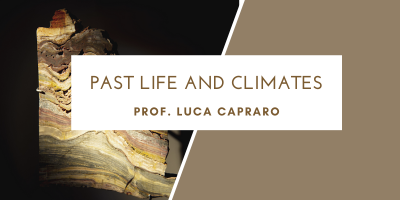Past Life and Climates

Period: first semester
Course unit contents:
Module 1 - Past Climates
Compelling evidence indicates that, since the early days of its Byr-long history, our planet had to cope unceasingly with changes in regional and global climates, which occurred on different time scales and amplitudes. However, predictive models proved to fall short when attempting precise forecasts of future climate trends, since the Earth climate system is complex, manifold and hardly predictable in its behavior. Crucial insights are provided by investigating the climate history in the Geologic past, which holds the key for understanding the future of our planet.
The Course will be organized as follows:
1 - Introduction to the Climate System (3 CFU).
Climate: definitions and calculation of the Earth radiative balance. Elements of descriptive and dynamic Oceanography. The astronomical theory of climate. Stable oxygen isotopes for paleoclimate reconstructions.
2 - Past climates of the Earth (3 CFU)
The great Proterozoic and Paleozoic glaciations. Mesozoic:
from the Early Triassic wastelands to the Cretaceous Thermal Maximum. Paleogene: the beginning of the Southern Hemisphere Glaciation. The Neogene and the Northern Hemisphere Glaciation.
The Pleistocene: evolution of climate cycles and orbitally-paced glacial dynamics. High-frequency climate variability: the Holocene. Climate cycles at the centennial and decadal scales. Open discussion (class lab).
Module 2 - Past life
Proxies are physical, chemical and biological materials preserved in the geologic record allowing for the estimation of climatic or environmental parameters. Proxy-based reconstructions span all timescales and provide a tool to better understand how climate and environments has varied through time both before and after human-related alteration of the Earth. Within this framework the module will be organized as follows:
1. Introduction to Past Life: main geological archives (sediments, corals, trees, ice cores, and instrumental datasets) in terms of completeness, resolution and time frame; main proxies in terms of calibration methods and their potential applications in reconstructing past environments and climates; reminders on the chemical and physical proxies covered in module 1;
2. A reminder of biostratigraphy and taxonomy,
3. Relationships among climate, biotic evolution, and ecology in the past;
4. Biotic Proxies and Microfossils. a) Organic-Walled Microfossils (dinoflagellates, pollen and spores): introduction, elements of systematics, paleoclimatic and paleoenvironmental significance, case studies. (Frontal Lectures + Laboratory). b) Siliceous Microfossils (diatoms, radiolarians, andsilicoflagellates): introduction, elements of systematics, paleoclimatic and paleoenvironmental significance, case studies. (Frontal Lectures + Laboratory). c) Calcareous Microfossils (Foraminifera and calcareous nannoplankton): introduction, systematics, applications in paleoclimatology and paleoenvironmental reconstructions. Laboratory sessions focused on systematics and stratigraphic, paleoenvironmental and paleoclimatic applications.
Planned learning activities and teaching methods:
The use of AI tools during the course will not be allowed.
In addition to contacting the course instructor, students with disabilities, Specific Learning Disorders (SLD), Special Educational Needs (SEN), and other health conditions can reach out to the Student Services Office - Inclusion Unit to receive more information about opportunities to access teaching with specific support and tools.
Module 1 - Past Climates
Frontal lectures (6 CFU = 48 hours) with the support of PowerPoint presentations, during which the main course topics will be discussed. Interactive discussion and students’ contribution to the debate will be encouraged.
Module 2 - Past Life
Frontal lectures (5 CFU); Class laboratories (1 CFU). Lectures with the support of on-screen presentations.
During the frontal lectures, key topics will be introduced, and their critical discussion will be promoted by questions. These topics will be further examined in subsequent laboratory sessions.
- Laboratory activities will include the following:
1) Group work to analyze a case study.
2) Identification under microscopy of main microfossil groups utilized as paleoenvironmental proxies.
3) Identification under microscopy of foraminifera and calcareous nannoplankton at the genus level. Initially the teacher will provide the necessary tools to identify these forms. Students will then work autonomously, while engaging with one another under the teacher's supervision, to identify under microscope the taxa presented in some selected samples. Finally, a group discussion will be held to interpret the paleoclimatic and stratigraphic significance of the analyzed samples, in order to contextualize their paleoenvironmental implications.Whenever possible, seminars led by specialists - both online and in person - will be organized to give students opportunities to discuss and deepen their understanding of selected topics.
